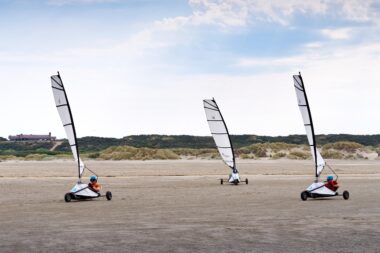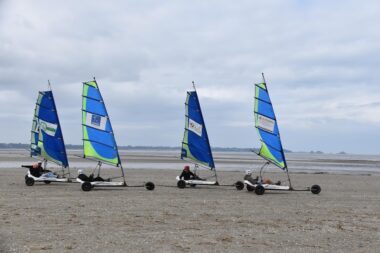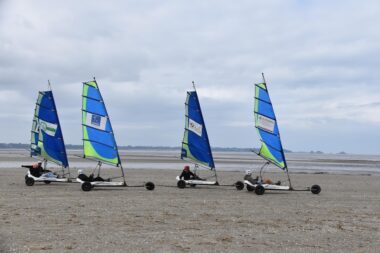How Weather Conditions Affect Sand Yachting Experience
Sand yachting is an exhilarating outdoor sport characterized by unique experiences on sandy terrains. Weather conditions play a critical role in determining the enjoyment levels of this activity. Wind speed and direction are perhaps the most significant factors influencing sand yachting. Optimal wind conditions can enhance speed and control, making for an enjoyable outing, while insufficient wind can dampen the overall experience. Furthermore, wind gusts can challenge even the most skilled riders as they navigate unpredictable terrain. Rain can also affect sand consistency, creating softer dunes that affect the yachting dynamics. High humidity can lead to poor visibility, which presents its own set of challenges for riders. However, sunny weather with mild temperatures tends to attract more enthusiasts. Riders often check forecasts to understand potential weather patterns, preparing for the best adventures. Wind can change throughout the day, encouraging yachters to adjust their strategies accordingly. Knowing how to adapt based on these conditions is pivotal for engagement. As enthusiasm grows, proper gear becomes essential to counter any sudden weather variability, ultimately enhancing the overall thrill of the sport.
Experienced sand yacht riders often share insights about the impact of different conditions on their rides. For instance, strong winds ranging between fifteen to twenty-five knots create thrilling experiences. However, wind speeds exceeding thirty knots can become dangerous, especially for inexperienced riders. The challenge lies in balancing fun and safety. Challenging weather entails preparing for increased risks but also fosters camaraderie among participants. When conditions become adverse, riders often come together, sharing tips and techniques to adjust. Sand quality is another critical factor influenced by weather. Dry, compact sand enables smoother gliding and excitement, while loose sand can hinder activity. During certain seasons, conditions can change rapidly, thus requiring constant vigilance among riders. Colder temperatures during winter months can deliver unique challenges, including frost and ice on some shorelines. Riders need to dress appropriately while ensuring the safety of their yachts in freezing conditions. Many enthusiasts utilize these seasonal transitions for training and honing their skills. Experienced yacht riders advocate for joining local clubs or communities to enjoy supportive environments. These communities foster a culture of sharing knowledge about handling various weather conditions effectively, enhancing the overall experience.
Preparing for Different Weather Conditions
Preparation is key when engaging in sand yachting amidst variable weather. Riders should be equipped with essential gear to protect against unexpected changes. A reliable weather app or website can help detect wind patterns and temperature forecasts to plan outings effectively. Adequate sun protection is essential while enjoying sunny days, including sunglasses and sunscreen. Additionally, appropriate clothing options allow for comfort during changing temperatures. When wind speeds are predicted to rise, ensuring one has a well-maintained yacht becomes crucial for both performance and safety. Riders should check their equipment regularly before hitting the sand, ensuring wheels are in good condition. Being familiar with yacht mechanics can save time and frustration during outings. Engaging with experienced members of the sand yachting community provides valuable insights into weather adaptation strategies. This knowledge can significantly enhance preparedness. Furthermore, understanding the local geography aids in making informed decisions about where to go when weather conditions are unpredictable. Riders must be adaptable, changing their routes or plans based on real-time weather changes during their outings. This flexibility ensures minimizing hazards, ultimately fostering a positive experience in the world of sand yachting.
When it comes to safety, understanding the limits of one’s abilities in various weather conditions is paramount. Many beginner riders often overestimate their capabilities in strong winds. Common safety measures include adhering to local regulations that dictate permissible conditions for riding. Monitoring wind forecasts allows riders to assess risk levels before embarking on their adventures. Furthermore, it is beneficial for sand yacht enthusiasts to organize outings as teams, enhancing communication and safety. When working in teams, shared decision-making becomes easier, especially when tricky weather changes arise. Potential dangerous situations can be mitigated with enough forethought and adequate planning. For instance, knowing when to call off a ride can prevent accidents and preserve the well-being of everyone involved. The location of the outing also influences safety. Selecting spots with clear escape routes is crucial, especially when sudden wind changes occur. Participants should always have a plan B in case conditions turn unfavorable. Team riding provides opportunities to learn from experienced members about respecting boundaries and safety protocols across varying weather situations. Building relationships in the sand yachting community creates a sentiment of accountability, fostering greater enjoyment for all involved.
Enjoying the Thrills despite Weather Variability
Despite facing different weather conditions, many sand yachting enthusiasts embrace these challenges to keep the excitement alive. Experimenting with different types of winds opens opportunities to learn new techniques and strategies. Whether riding in challenging winds or navigating softer sands, adaptability fosters skills development. Seasoned riders excel at making the most out of adverse conditions, sharing their tactics with newcomers. For many, even rainy weather can be refreshing, providing unique experiences on the beach. Rain can stabilize sand and improve traction conditions, allowing for thrills in unexpected moments. Learning to read weather patterns enables riders to anticipate changes effectively. Self-reflection during outings contributes to personal growth, helping participants understand not only riding techniques but also their limits. In partnership with knowledgeable peers, challenges navigate through unpredictable terrains and provide deeper engagements with the sport. Building resilience through adversity empowers individuals to appreciate the sport fully. Evaluating post-outing experiences entails sharing feedback and strategies, enhancing everyone’s future rides. As weather changes, so too does the opportunity for bonding and community-building within the sand yachting experience.
Embracing technological advancements has also revolutionized how riders approach weather conditions in sand yachting. New navigation tools provide real-time updates about conditions, ensuring safety during rides. Many passionate riders invest in handheld devices that assist with tracking wind speeds, temperature, and overall forecasts. These devices expand opportunities for exploration by allowing riders to venture into new locations confidently. Social media platforms now also serve as valuable sources for learning about local conditions and seasonal variations. Online forums connect enthusiasts to share important insights about weather effects on the sand yachting experience. Riders are continuously encouraged to document their adventures through blogs and social media, sharing valuable experiences with others. Knowledge exchange creates opportunities for growth and elevates the sport’s standards. Podcasts and YouTube channels dedicated to sand yachting can also offer exciting new content featuring weather tips. Overall, embracing technology can lead to a more informed sand yachting community. Maintaining an active online presence supports engagement among enthusiasts, building relationships that extend beyond the sandy dunes. Adventure awaits for those eager to stay connected, ensuring adaptability with ever-evolving weather conditions.
Conclusion: The Future of Sand Yachting in Varying Conditions
In summary, weather conditions significantly affect the sand yachting experience, presenting both challenges and thrilling opportunities. As participants navigate through varying wind conditions, the sport continues to attract robust communities of passionate individuals eager to share experiences. Preparing adequately for outings empowers individuals to make informed decisions based on predictions and actual weather patterns. This preparation includes utilizing technological advancements for safety and increased performance. Riders are encouraged to build relationships within communities, fostering an environment for shared learning and camaraderie. Ultimately, the beauty of sand yachting lies in embracing the dynamic nature of weather while reaping the benefits of adaptation. The excitement of sand yachting thrives on this variability, continually pushing the boundaries of experience for both enthusiasts and newcomers alike. As individuals approach their next adventures armed with knowledge and community support, there’s no telling how far their skills may be honed. The future of sand yachting holds immense promise as awareness grows, engaging even more individuals to take to the dunes confidently. Every ride not only showcases individual abilities but also expresses the broader culture of resilience and passion inherent in the sand yachting community.





